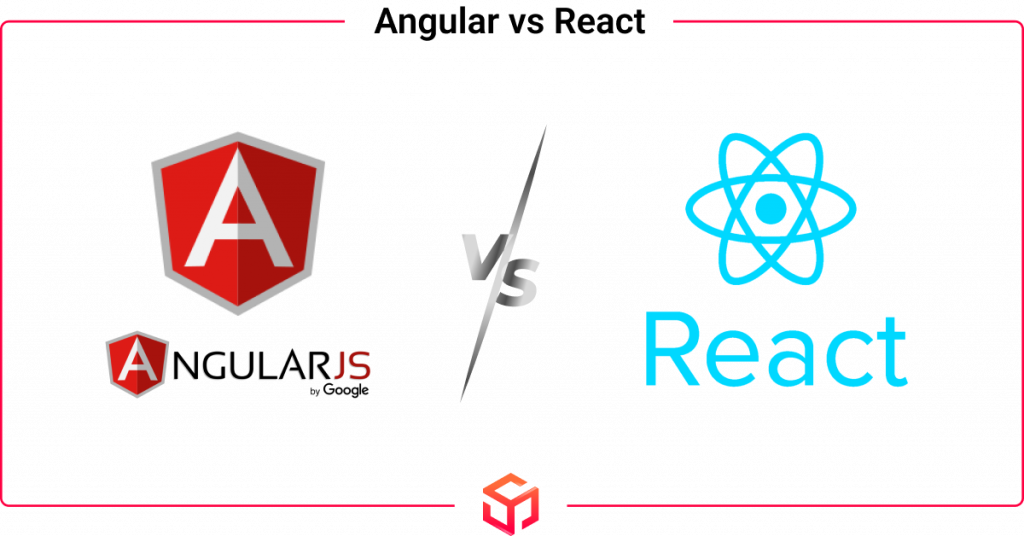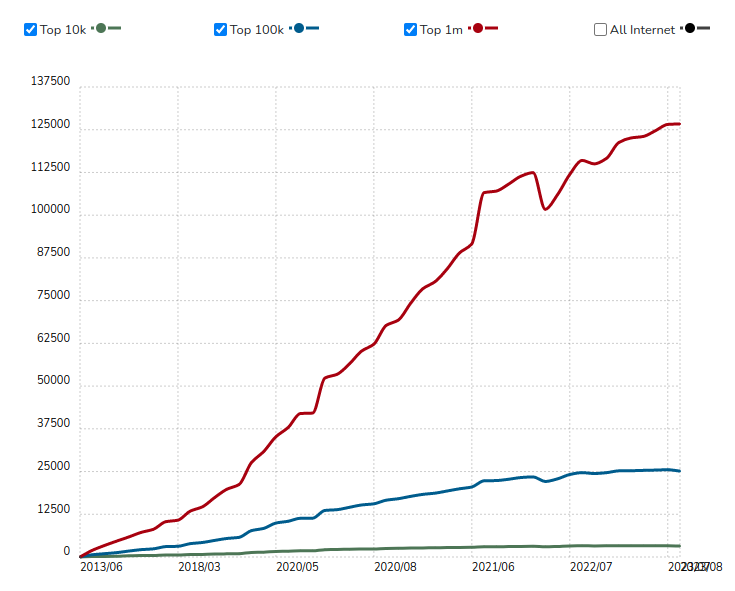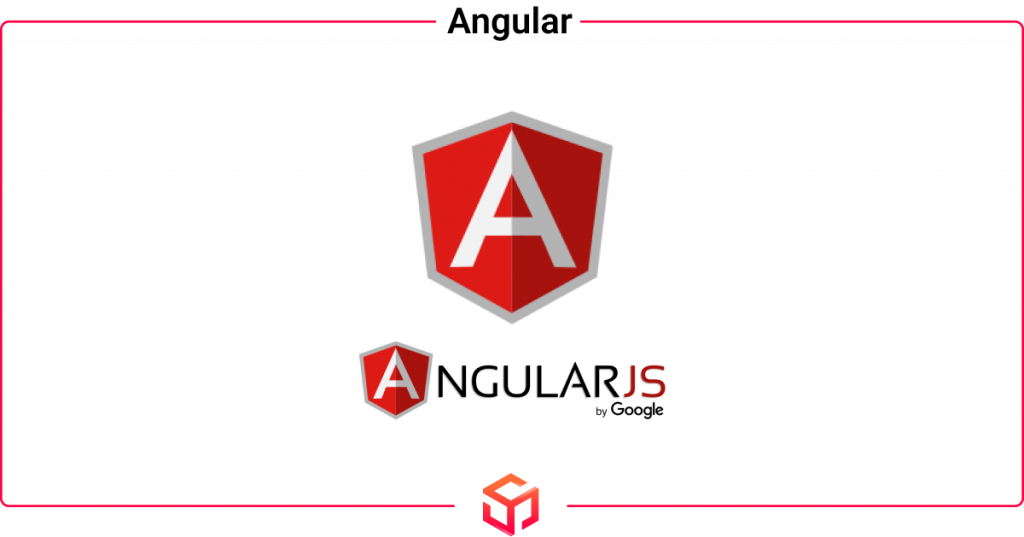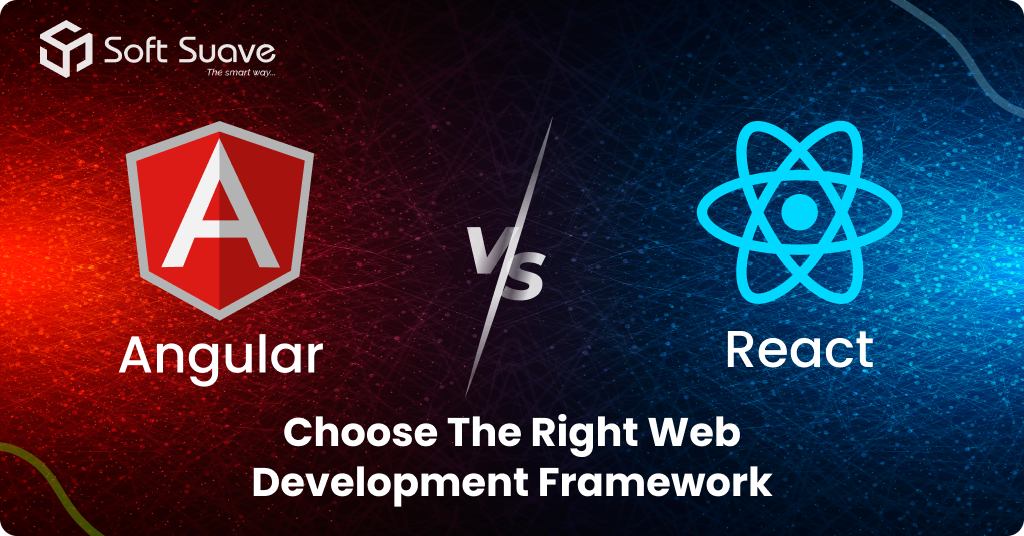Angular vs React are the two most popular front-end development frameworks in today’s market. These frameworks are in the top 15 list of JavaScript Frameworks in 2024. Tough task to choose between React and Angular.

In Web application development, it is hard to distinguish any one tool as the best. Each one will have its own merits and demerits.
A feature that is beneficial in one instance might prove to impede another. To avoid increased development time, selecting the right framework is imperative. This requires diligently considering them according to the situation.
If you’re into JavaScript, you’ve probably pondered whether to go with Angular or React.
Many business owners are attempting to choose between these two popular frameworks. Even though they’re different, Angular vs React are both good options for building the front end of your website.
These frameworks are great for user experience, performance, and cost. Reacts architecture is based on components, encouraging code reuse. This lets developers package and reuse UI components across various sections of their applications.
Just like different illnesses need different medicines, different projects need different frameworks. We’re here to help you understand the differences between React and Angular and find the best one for your project.
Take Your Business with the Right Choice!
Explore how Softsuave can guide your project to success.
Comparison Between Angular And React
React and Angular are both widely used JavaScript frameworks for creating advanced and interactive web applications. While they have some similarities, there are also key differences that make them unique. Before we dive into the technical details, The following chart provides a comparative overview of the basic factors in these two frameworks:
| FACTOR | ANGULARJS | REACTJS |
| Release | 2016 | 2013 |
| Type | JS framework | JS Library |
| Data Binding | Bidirectional | Unidirectional |
| Language | TypeScript | JavaScript |
| DOM | Real | Virtual |
| Learning Curve | Steep | Flat |
| License | MIT License | MIT License |
| Maintenance | ||
| Abstraction | Strong | Medium |
| Architecture | Component-based | Component-based |
Google supports Angular, an open-source front-end development framework. ReactJS is an open-source JavaScript library introduced by Facebook.
An In-Depth Comparison Of Angular And React Characteristics
An in-depth comparison of Angular and React characteristics involves evaluating various aspects of these two popular JavaScript frameworks used for building web applications. Here’s a breakdown of the comparison:
Language Expertise
In regard to language expertise, Angular makes use of the comparatively new TypeScript. TypeScript was released in 2012 and is used by a limited number of people. React makes use of JavaScript released in 1995 that naturally has a far larger number of users. This ensures the possibility of reaching a larger community in a time of need.
It must also be considered that TypeScript language is statically typed whereas JavaScript is dynamically typed. Up to the decision of the Web Application Development Company to pick one of these frameworks.
It should be noted that statically typed languages are susceptible to typos and typically demand more time for fixing and debugging. Dynamically typed languages help testing and development times.
Architecture
Angular Vs React in the purview of architecture is framework Vs library. Angular happens to be a complete MVC framework, the descendant of AngularJS. On the other hand, React is more of a library that has UX components. Only the view component is available, necessitating using other libraries for the other components.
React framework with its minimalistic approach allows adding customized libraries/components. On the contrary, with Angular, pre-existing libraries must be accommodated. If the existing libraries are required for your app, then AngularJS development would be a perfect choice. However, sometimes, the libraries may not be available in both Angular and React. In such a case, this criterion will not be taken as the deciding factor.
Web app developers will find a bundle of components such as AJAX requests, XSS protection, routing, and forms available in Angular. React is equipped with minimal in-built features. It thus enables Software application development companies to build libraries themselves according to unique needs.
Third-Party Library Use
TypeScript helps counter JavaScript’s steep learning curve. Nonetheless, it becomes a hindrance when third-party libraries are included. TypeScript requires definitions of every library that have to be used. This makes working with third-party libraries inconvenient.
Scalability
With a robust design and command line interface, Angular proves highly scalable. React being easier to test makes it easy to scale too. The choice of the framework is purely on the developer in this regard.
Frameworks
Both React and Angular have their web development frameworks. React is equipped with React Native, React Sketchapp, and next.js, whereas Angular has a native script and ionic 2
The application performance and ease of development, React native proves to be the best framework. While other frameworks work fine too, it is the app developer’s choice and specific needs that drive the decision.
Licensing
Angular has a free open-source license, making it easier for companies to adopt. React—coming from Facebook—initially had certain patent clauses that didn’t suit several enterprises.
However, after being re-licensed under MIT, it became extensively accessible. Regardless, one should carefully consider finer points when selecting React.
Speed
Angular takes comparatively a little more time for loading on mobiles. React loads swiftly with its sleek design. Especially after introducing the Fiber architecture, it loads fast.
Even the latest version of Angular cannot match React loading time. React Js Development suits those who give priority to speed.
What is React?
React, referred to as React.js, represents a JavaScript library designed for constructing user interfaces. Facebook, along with a consortium of individual developers and corporations, oversees its maintenance and development.

React allows developers to create reusable UI components and build complex UIs with ease. Its virtual DOM (Document Object Model) offers high performance by minimising the need for direct DOM exploit.
ReactJS is used by 13,266,258 live websites. Additionally, 7,021,578 websites have adopted THIS FRAMEWORK historically.

Advantages of React JS
React JS provides numerous front-end benefits for both users and developers. Below are some key advantages of React JS that you can take:
Performance Optimisation:
React’s virtual DOM efficiently updates and renders only the necessary components, leading to improved performance and faster user interactions. This optimization minimizes DOM manipulation and enhances the overall responsiveness of web applications.
Community Ecosystem:
React benefits from a thriving and vibrant community of developers, contributors, and enthusiasts.
Code Reusability:
React is an architecture based on components, emphasizing code reusability and modularity. This enables developers to encapsulate and reuse UI components across various sections of their applications.
This modular approach streamlines development, reduces code duplication, and facilitates easier maintenance and updates, thereby enhancing productivity and code maintenance.
Enhanced Developer Experience:
React simplifies the process of building user interfaces by employing a declarative and component-based paradigm. This abstraction removes the need to handle complex DOM manipulation and state management logic directly. This abstraction enables developers to focus on writing clean, readable, and maintainable code, resulting in a more enjoyable and efficient development experience.
State Management:
React provides several state management solutions, including the Context API and third-party libraries like Redux. These tools enable developers to efficiently and predictably manage application state. Effective state management is essential for creating scalable and maintainable applications, ensuring seamless data flow and synchronization between components.
React offers a comprehensive set of lifecycle hooks that enable remote developers to access various stages of a component’s lifecycle, including mounting, updating, and unmounting. These lifecycle hooks empower developers to conduct tasks such as data fetching, state updates, and cleanup operations. They enhance control and flexibility in managing component behavior and interactions.
The React ecosystem provides developers with an extensive array of tools, such as React Developer Tools, Redux DevTools, and multiple debugging extensions compatible with popular web browsers. These tools give developers valuable insights into component hierarchy, state changes, and performance profiling. They facilitate efficient debugging, optimization, and troubleshooting throughout the development and testing stages.
Compatibility with Existing Code bases:
React’s adoption model is flexible and incremental, making it compatible with existing code bases and frameworks. This allows developers to gradually integrate React components into legacy applications or alongside other technologies without disrupting the existing workflow or architecture. This enables seamless migration and modern applications while preserving investments in existing infrastructure and technology stacks.
Also Read:- Node.Js Vs Python: Which Is The Best Technology For Web App
What is Angular?
Angular stands tall as an open-source JavaScript front-end framework, crafted and managed by Google’s esteemed Angular team. Boasting unparalleled versa, Angular serves as the pinnacle choice for crafting dynamic and robust mobile and web applications.

The Power of Angular
Angular empowers developers with a comprehensive toolkit, seamlessly integrating HTML, CSS, and TypeScript to sculpt stunning interfaces and functionalities. Its growth and performance elevate it as the cornerstone of modern application development.
A New Era: Angular vs. AngularJS
Angular emerges as a triumphant successor to AngularJS, a testament to Google engineers’ relentless innovation. Unlike its predecessor, Angular undergoes continuous refinement, permanently evolving to meet the dynamic demands of the digital landscape.
Dive into Web Development Excellence!
Explore how Softsuave can shape your project’s future.
Benefits of Angular
Angular is a powerful JavaScript framework developed and maintained by Google, offering several advantages for web developers. Here are some key benefits of using Angular:
Modular Architecture:
Angular’s modular architecture facilitates the development of large-scale applications by breaking them down into smaller, manageable modules. This modular approach encourages organized, reusable, and maintainable code. It enables developers to encapsulate functionality into cohesive units and effortlessly add or remove features as required.
Typescript Integration:
Angular employs TypeScript, a statically typed superset of JavaScript, to provide robust typing, enhanced tooling, and superior error detection throughout the development process.
Two-Way Data Binding:
Angular’s two-way data binding feature seamlessly keeps the model and the view synchronized, eliminating the necessity for manual DOM manipulation and reducing boilerplate code.
Powerful CLI Tools:
The CLI simplifies common development tasks and follows best practices such as generating components, services, and modules, optimizing build configurations, and automating test execution. This enhances developer productivity and ensures consistency across projects.
Built-in Routing and Navigation:
Angular offers a robust routing and navigation system that allows developers to define multiple routes, nested routes, and route guards for controlling access to different parts of the application. Angular’s router seamlessly integrates with the browser’s navigation history, enabling users to navigate between views and maintain the application’s state and URL structure.
Template Syntax and Directives:
Angular’s expressive template syntax and powerful directives enable developers to create dynamic and interactive user interfaces with ease. Angular templates facilitate data binding, event handling, conditional rendering, and loop iteration. They empower developers to define UI logic and behaviour without heavily relying on imperative JavaScript code.
Cross-Platform Compatibility:
Angular’s architecture and design principles make it perfect for building cross-platform web applications that smoothly run on desktops, mobile phones, and tablets alike. Angular enables packaging and deploying applications as Progressive Web Apps (PWAs), providing offline access, push notifications, and installation prompts to enhance user engagement.
Comprehensive Documentation and Community Support:
Angular benefits from extensive documentation, tutorials, and guides offered by both the Angular team and the broader community of developers and contributors. The official Angular documentation encompasses various subjects, such as beginner guides, API references, best practices, and advanced topics. This comprehensive coverage facilitates developers in learning, troubleshooting, and mastering Angular development.
Enterprise-Grade Support and Long-Term Stability:
Angular, supported by Google, benefits from a dedicated team of engineers, contributors, and community members. Google’s unwavering commitment to Angular ensures its long-term stability, security, and backward compatibility, making it a reliable choice for enterprise-scale applications and mission-critical projects.
Also Read:- Node.Js Vs AngularJS: Which Is The Best For Your App – [Infographic]
Pros and Cons of using Angular vs React for web apps
Let’s take a closer look at the advantages and disadvantages of using Angular and React for web applications:
Pros:
Angular is a robust and comprehensive front-end framework developed and maintained by Google. It offers several advantages for building web applications:
Comprehensive Framework:
Angular offers a comprehensive web development solution, equipped with built-in tools and features such as routing, forms, and HTTP client functionality.
Two-Way Data Binding:
Angular’s two-way data binding streamlines model-view synchronization, minimizing the necessary boilerplate code.
Strong Community Support:
Angular benefits from a large and active community of developers, providing extensive documentation, tutorials, and third-party libraries to facilitate development.
Cons:
Cons of Using Angular for Web Apps: While Angular offers numerous advantages for web application development, it also comes with certain drawbacks and considerations:
Steep Learning Curve:
Angular presents a challenging learning curve, particularly for developers new to web development or transitioning from other frameworks. Its comprehensive nature and reliance on TypeScript may require additional time for proficiency.
Opinionated Structure:
Angular follows an opinionated structure and design patterns, which may limit flexibility and creativity in certain scenarios. Any kind of web developer may find themselves constrained by Angular’s conventions, especially when working on unfamiliar projects.
Complexity of Documentation:
While Angular’s documentation is comprehensive, it can sometimes be overwhelming in its depth and complexity. Navigating through the documentation may require additional effort, especially for beginners.
Performance Overhead:
Angular applications may incur a performance overhead because of its extensive features and complex rendering process. Developers often need to perform careful optimization and tune performance to ensure optimal functionality, particularly for large-scale applications.
Pros and Cons of Using React for Web Apps:
Using React for web applications presents several advantages and disadvantages.
Pros:
React is a popular JavaScript library developed and maintained by Facebook. It offers several advantages for building web applications:
Lightweight Library:
React is a lightweight library that focuses solely on the view layer, allowing developers to easily integrate it with other libraries and frameworks as needed.
Virtual DOM:
React’s virtual DOM offers efficient rendering by minimizing the need for direct DOM manipulation. This results in improved performance and a smoother user experience, especially for complex UIs.
Component-Based Architecture:
React promotes a component-based structure, empowering developers to create modular, reusable UI components. This enhances code maintenance and is scalable, especially in large applications.
Cons:
Here are some key cons of using React for web apps:
Need for Additional Libraries:
Although React itself is lightweight, developers frequently find themselves integrating additional libraries to incorporate features such as routing, state management, and form handling. This can lead to a fragmented ecosystem and require careful selection of compatible libraries.
Learning Curve for JSX:
React’s use of JSX, which extends JavaScript syntax, may require developers to understand new syntax and concepts, especially if they are unfamiliar with HTML-like structures within JavaScript.
Limited Built-in Features:
In contrast to Angular, React lacks built-in solutions for common tasks like routing and HTTP requests.
Even though there are third-party libraries, developers may need to spend time selecting and integrating the right tools for their project.
Ready to Make a Decision?
Get in touch with Softsuave for tailored solutions and expert advice.
Server-side rendering: Angular vs React
Angular: With server-side rendering, Angular generates a static view of the application before it becomes fully interactive.
You can strategically use a combination of JSON and client-side caching to improve server-side performance.
Angular stands out for its ability to minimize communication between the client and server.
React: To ensure your application is SEO-friendly, rendering it on the server is necessary. React accomplishes this effortlessly with the aid of specific functions. You can achieve this by utilizing the RenderToString function instead of Render. Unlike other JavaScript frameworks, React is not overly rigid and provides significant flexibility.
Difference Between Angular and React for Web Development
Learning Curve: React has a shallower learning curve compared to Angular, making it more accessible to beginners.
Community Support: React boasts a large and active community with abundant resources and third-party libraries. Angular also has a supportive community but may have fewer resources compared to React.
Flexibility:React offers more flexibility integrating with other libraries and frameworks. Angular, on the other hand, follows a more opinionated approach, which may limit flexibility in certain scenarios.
Angular or React – Which is Better Choice?
In web application development, developers frequently utilize Angular and React, each showcasing distinct strengths tailored to various project requirements.
Facebook developed React, which is renowned for its simplicity and flexibility. It allows developers to build reusable UI components and manage the application state efficiently. React’s virtual DOM enables faster rendering and updates, leading to better performance. It offers features like two-way data binding, dependency injection, and routing, which can accelerate development for larger projects.
Ultimately, the decision between Angular and React depends on your project’s specific requirements and your development team’s preferences. Take into account the project’s scope and the expertise of your developers, as both frameworks have their advantages.
React has undergone significant changes, empowering ReactJS development companies to provide feedback easily on experimental APIs, new features, and JavaScript syntax enhancements. Meanwhile, Angular has experienced growth in usage rates.
Experts expect development in both AngularJS and ReactJS to remain prevalent for several years. The choice of framework for web application development depends on the complexity and unique app requirements. The experience of hired developers also plays a significant role in making this decision.
Need Expert Guidance?
Softsuave offers web development solutions tailored to your needs.
Conclusion:
React has introduced a few major changes. These empower ReactJs Development companies to provide feedback easily on experimental APIs, new features, and JavaScript syntax enhancements. On the other hand, Angular has been witnessing growth in the rate of usage.
Both Angular Js development and React Js Development are here to stay for several years. The choice of framework for web application development relies on the complexity and specific requirements of the application. The experience of the hired app developers is also another factor that influences this choice.
We’re here to help. Reach out to Soft suave where our experts are ready to tailor software development solutions to your business’s exact requirements
FAQs
How is React different from Angular?
Both React and Angular are renowned JavaScript frameworks, each boasting its own unique architecture. Angular serves as a complete MVC framework, requiring more effort to learn, while React functions as a JavaScript library emphasizing component-based development, making it easier for beginners to grasp.
What are the key differences between Angular and React?
Angular is a full-fledged framework with built-in features for routing, forms, and state management, while React is a library focused on building UI components.
Is Angular suitable for large-scale applications?
Yes, Angular is suitable for building large-scale applications with complex features and requirements. It provides built-in solutions for handling routing, forms, HTTP requests, and state management, making it well-suited for enterprise-level projects.
Is React suitable for large-scale applications?
Certainly, React is also suitable for large-scale applications. Its lighter weight compared to Angular developer can extend React with additional libraries and tools to effectively handle complex application logic and state management.
The adept Project Manager at Soft Suave Technologies. With a strategic mindset and commitment to excellence, Madhu ensures successful project delivery. His leadership blends innovation with established methodologies, fostering a culture of continuous improvement. Connect with Madhu to explore how Soft Suave’s projects thrive under his expert guidance.


